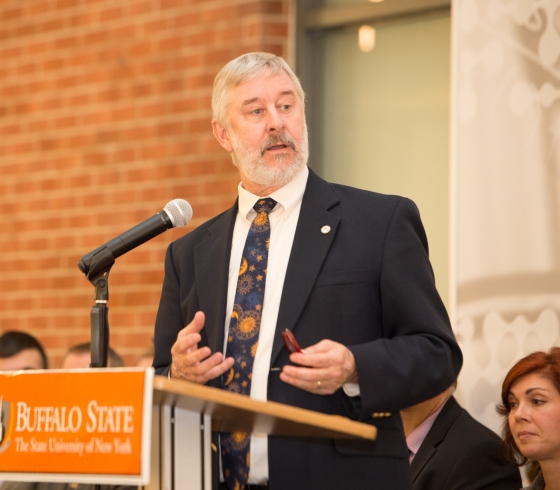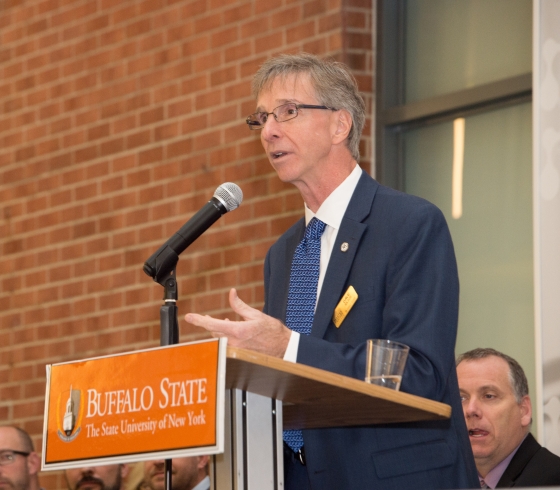
Although they’re the ones at the front of the classroom, teachers in the Western New York chapter of New York State’s Master Teacher Program (NYSMTP) are committed to lifelong learning. Through ongoing professional development and collaboration, these educators continually sharpen their skills to become leaders in teaching.

David Henry, Ph.D.
Master teachers are exemplary K-12 educators who demonstrate strength and articulate clear goals for further developing their breadth and depth in three domains: knowledge of Science, Technology, Engineering, or Mathematics (STEM) content; knowledge of pedagogy; and knowledge of students, their families, and their communities. To be considered for this designation, a teacher must be a certified NYS public school teacher for grades K-12 with at least four years of teaching experience and consistently demonstrate the qualities of a professional educator by maintaining a rating of “Effective” or “Highly Effective”—or the equivalent—on their annual professional evaluation and remaining in good standing in their respective school community.
Master teacher candidates must also agree to participate in a minimum of 50 hours of NYSMTP-created programming each program year, with a percentage of this time dedicated to assisting with the professional development of other in- or preservice colleagues through mentorship or other activities. (Most master teachers participate at levels significantly higher than the minimum requirement.)
Buffalo State University has served as the Western New York chapter’s host campus since NYSMTP began in 2013. This means that Buffalo State not only serves as home-base for the region, but also partners with other educational institutions and organizations to provide consistent programming designed to help master teachers toward their goals.
Wendy Paterson, Ph.D. and current Dean of the School of Education, said Buffalo State was a natural choice for this role.

David Wilson, Ph.D.
“Our high level of participation in over 100 regional schools and all WNY school districts helps our faculty and teacher candidates stay completely current in all aspects of today’s schools and teachers,” she said. “With programs spanning the K-12 continuum coupled with a distinguished record of graduating highly effective school and school district leaders, Buffalo State welcomed the opportunity to showcase the innovative and provocative STEM teachers we know from observation and networking.”
All three of the WNY chapter’s regional directors—David Henry, Lisa Brosnick, and David Wilson—are full-time faculty members at Buffalo State.
“We are better teacher educators because we work with the master teachers in the field as part of our work with teacher education programs,” said Henry, an associate professor in the Elementary Education, Literacy, and Educational Leadership Department. “We are constantly learning from master teachers and bringing new methods back to our Buffalo State classrooms.”
Buffalo State’s active involvement in NYSMTP continues to advance science, technology, engineering, and mathematics education not only on campus, but throughout the Western New York community. Here's how.

Furthers Buffalo State’s identity as the place to become a great teacher
Buffalo State’s role as the host campus for the WNY region demonstrates its commitment to the creation and development of outstanding teachers.
Since it opened its doors as a New York state teachers college in 1871, Buffalo State has been the gold standard in teacher education. Today, the university offers more than 55 pathways to become a teacher, allowing students to choose a program that most specifically meets their interests and future employment goals. Within the first year after graduation, 89 percent of Buffalo State teacher education alumni are working in the education field.
Master teachers frequently gather to participate in professional development. In addition to a mandatory monthly cohort meeting with all WNY Master Teachers, they also participate in:

Master teachers participate in professional development throughout the academic year.
- Professional Learning Teams: small teams of teachers/counselors who meet regularly to collaboratively learn, investigate, and implement best practices. (There are 14 unique PLTs for the 2024-2025 program year.)
- Professional Interest Group meetings: scheduled time for multiple Master Teachers/Counselors to meet to explore in an introductory way a professional topic that has value for them, to problem-solve around a particular educational issue they are facing, or to share resources and ideas.
- Collegial Circles: groups that grapple with ideas and issues in education, supported by use of print and digital texts.
- Outreach Groups: groups that develop activities and events that serve an audience external to the NYSMTP.
Buffalo State also offers mini courses for master teachers throughout the year. Teachers then bring this knowledge back to their own classrooms.

Provides educational benefits to Buffalo State students
The number of master teachers serving as Buffalo State adjuncts and lecturers continues to increase—currently, there are 13; the most recent additions were hired for the Fall 2024 semester.
“In a true cycle of partnership, while we serve as the site for NYSMTP activities, the master teachers themselves are often faculty for us,” Paterson said. “Drs. Wilson and Henry, who were co-directors from the inception of the program, are true exemplars of excellence in teaching in STEM. Two alumni of the program—Lisa Brosnick and Ed Hawkins—have joined our Career, Technical, and Science Education department. Lisa recently joined the leadership team, demonstrating a truly reciprocal benefit for STEM education offered here.”
The presence of master teachers on campus is important, said Henry, because it is where students get their first impressions of teaching as a career.

One of the WNY chapter's regional directors, Lisa Brosnick (center), was a part of the first master teacher cohort in 2013.
“Master teachers exemplify lifelong learning and a professional commitment to improving their practice,” he said. “When our preservice teachers see this in action, it gives them a sense of teaching as a profession requiring continual reflection and improvement.”
“Master teachers in Buffalo State’s Master Teacher Program are primary mentors for teacher candidates in Buffalo State STEM education,” said Wilson, a Buffalo State associate professor of mathematics. “That doesn’t happen at most schools. Buffalo State teacher candidates are in the classroom with master teachers, working alongside passionate educators as we prepare them for success in the classroom.”
Henry added that most of Buffalo State’s science, mathematics, and technology teacher candidates work with a master teacher in their field placements.
“Supervising these teacher candidates is such a pleasure,” he said, “because of the excellent teaching you know you will be observing.”

Generates community connection and collaboration
Buffalo State ignites and bolsters local students’ interest in STEM by hosting numerous programs and events throughout the year, including the IMPACT Conference, WNY STEAM Conference, the Bridges Lab, Rising Stars Summer Math Camp, Buffalo Math Collaborative, and Physics Olympics, which has been held on campus since 1988. While Physics Olympics existed before NYSMTP, the program now helps run the event and conducts significant outreach, resulting in a successful event that brings more than 100 local middle and high schoolers to campus each January.
Generating student interest in STEM degrees is critical and introducing them to campus increases the likelihood that they will choose to pursue that degree at Buffalo State.
Master teacher Jennifer Gazdovich, ’13, recalls her participation in Physics Olympics as a high school sophomore.

Master teacher Jennifer Gazdovich, '13
“I walked into my physics class my sophomore year of high school and my teacher said, ‘I signed you up for Physics Olympics at Buffalo State on Saturday,’” she said. “It seemed like a fun thing to do. Buffalo State was the first college campus I had ever been to. It was a cool experience.”
When it came time for college, Gazdovich said she was set on Buffalo State.
“Buffalo State was the only college I applied to,” she said. “I knew I wanted to become a teacher and Buffalo State was always referred to as the teacher school. It definitely helped already being involved on campus [with Physics Olympics] ahead of applying.”
After graduating from Buffalo State with a bachelor’s of science in physics, Gazdovich completed a master’s of science in secondary education. She is now a physics teacher at Kenmore West High School, and brings students to Physics Olympics on the Buffalo State campus each year.
“STEM is so important for our high schoolers to fall in love with during this crucial learning time when they are deciding what to do in life,” Gazdovich said. “Everyone wants to do something fun when they grow up, so we need to show them how fun STEM can be.”
To learn more about the Western New York chapter of NYSMTP, please visit the website.



